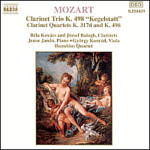
Mozart: Keyboard Trio No. 2 in E flat major, K. 498, Kegelstatt / etc
 $25.00
Out of Stock
$25.00
Out of Stock2-4 weeks add to cart
W. A. MOZART
Mozart: Keyboard Trio No. 2 in E flat major, K. 498, Kegelstatt / etc
Jozsef Balogh (clarinet) / Bela Kovacs (clarinet) / Jeno Jando (piano) / Gyorgy Konrad (viola)
[ Naxos / CD ]
Release Date: Monday 13 February 2006
This item is currently out of stock. We expect to be able to supply it to you within 2 - 4 weeks from when you place your order.
"finely performed, with lovely melodic touches from clarinettist Jozsef Balogh"
- Classic CD
"there are things to enjoy here"
- Gramophone
The clarinet in its more primitive form, a simple single-reed instrument of cylindrical bore, has an ancient history. The chalumeau, the form of the instrument known in 17th century Europe, was developed at the beginning of the following century to give a wider and higher range, with two contrasting registers, the so called chalumeau or lower register and the upper flute-like notes, now possible with an additional register key. The clarinet won only gradual acceptance as an orchestral instrument, notably in Vienna with the brothers Johann and Anton Stadler, engaged in the Imperial wind band from 1773 and from 1787 in the court orchestra. Anton Stadler, specialising in the lower register, experimented with a form of the instrument with a still lower range, now generally known as the basset clarinet, for which Mozart wrote his Clarinet Quintet and Clarinet Concerto, both designed for Anton Stadler.
Mozart's Kegelstatt Trio, for clarinet, viola and piano, was completed on 5th August 1786, its nick-name derived from the suggestion that the work was composed during the course of a game of skittles. The Trio was written for the Jacquin family and in particular for Mozart's pupil Franziska Jacquin, who presumably played it with Anton Stadler, with the composer himself playing the viola. When the work was published by Artaria in 1788, it was prudently advertised as for violin, viola and keyboard, a necessary commercial adjustment, with an added note that the violin part could be played instead on the clarinet.
Tracks:
Keyboard Trio No. 2 in E flat major, K. 498, "Kegelstatt"
Violin Sonata No. 26 in B flat major, K. 378 (arr. for clarinet and string trio)
Keyboard Trio No. 1 in G major, K. 496 (arr. for clarinet and string trio)

